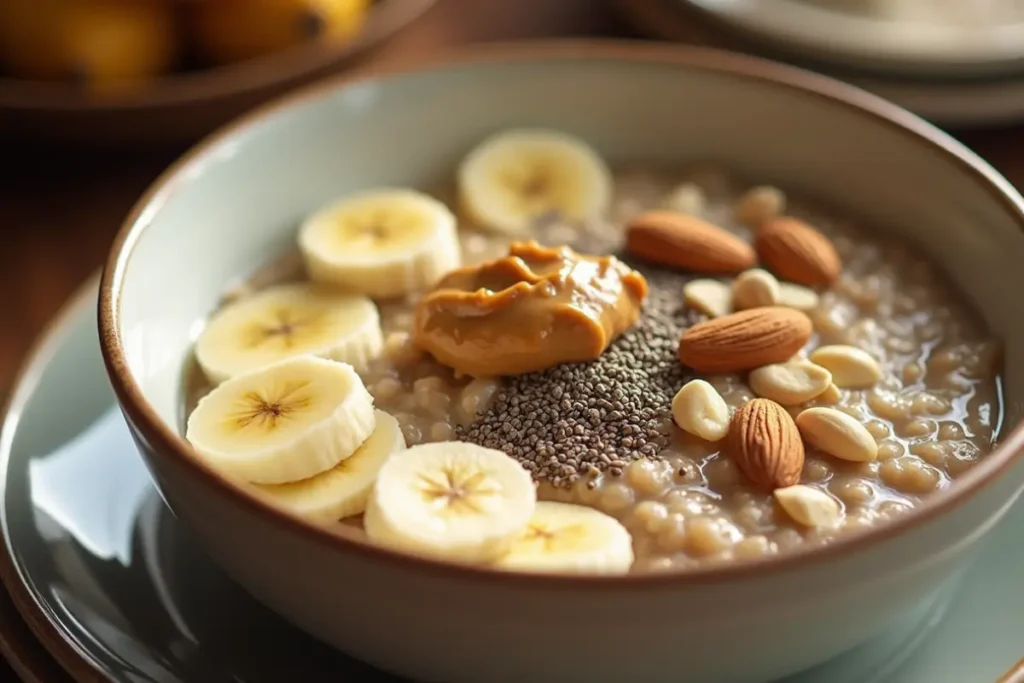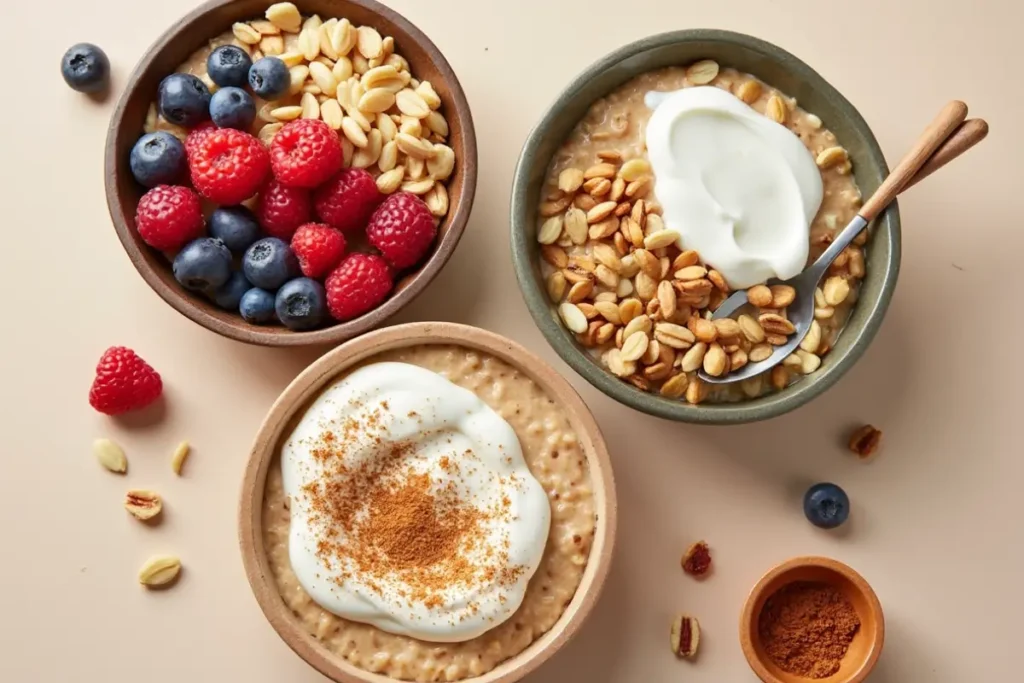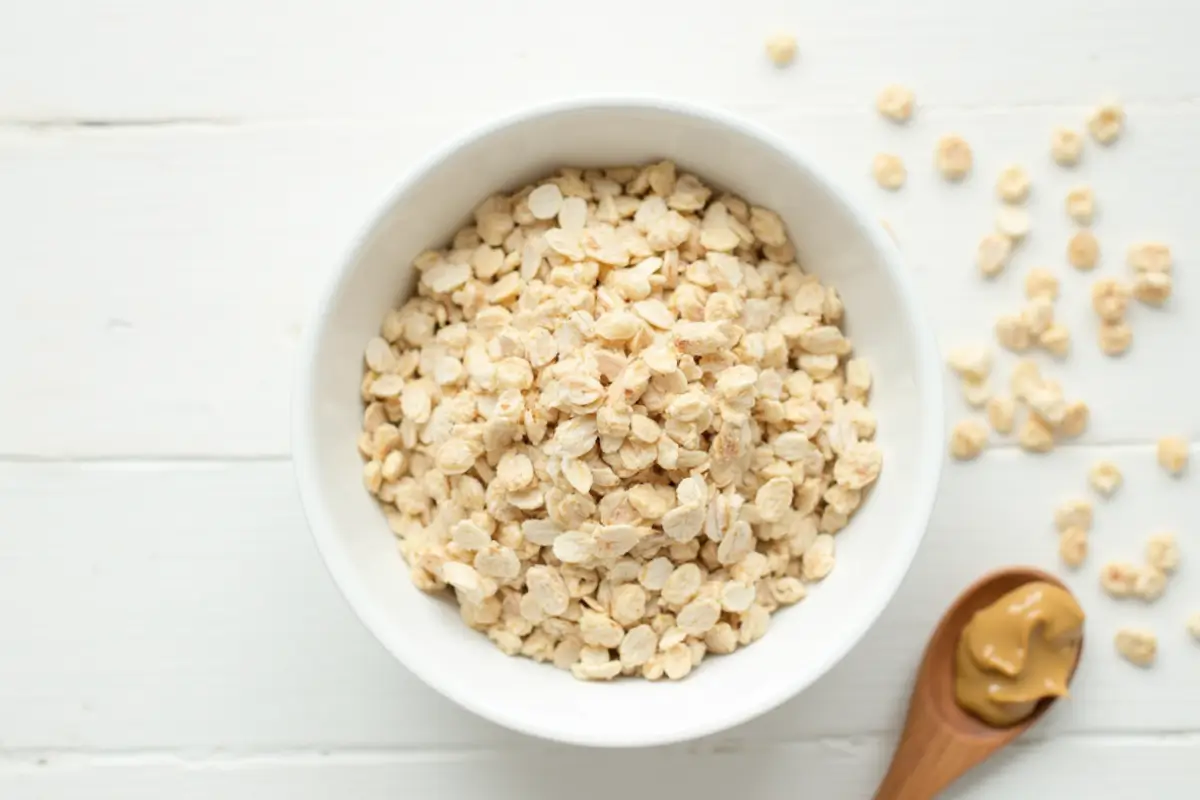Do you ever find yourself staring into your pantry, wondering if your go-to breakfast is truly giving your body what it needs? I’ve certainly been there, especially when trying to juggle busy mornings with a desire for nutritious choices, and often the question that comes to mind is: Is oatmeal high in protein? Oatmeal often feels like the perfect, comforting option, like a warm hug in a bowl. But then the nagging question arises: Is it really packed with enough protein?
We’re all striving for more energy and better health, aren’t we? That’s why we need to ensure that every meal, even something as simple as breakfast, is working for you. Therefore, today, let’s delve into the nutritional profile of oatmeal and answer the burning question: is oatmeal high in protein, and how can we make the most of its benefits? So, if you’ve been wondering if your morning bowl is giving you what you need, then you’re in the right place. Thus, let’s explore this together.
Understanding Oatmeal’s Nutritional Profile
First and foremost, before we zoom in on protein, let’s get a broader perspective on what oatmeal actually brings to the table. Oatmeal, a breakfast favorite across the globe, is, primarily, indeed, a complex carbohydrate. This is crucial to understand, since, in particular, it gives you sustained energy, preventing those mid-morning energy crashes. Think of it, instead, as the slow-burning fuel your body craves.
However, it’s not just about carbs. Oatmeal is also a good source of dietary fiber, specifically, a type called beta-glucan. Notably, this type of fiber is not just about keeping your digestive system in good order; moreover, it also plays a significant role in heart health and, furthermore, regulating your blood sugar levels. We’ll get into those specific details later on!
The nutritional profile of oatmeal is quite fascinating, offering various vitamins and minerals, although this depends on the specific type of oats you choose. For example, in this instance, here’s a snapshot of what you typically find in a half-cup serving of cooked oatmeal (though do remember this can vary slightly depending on the brand and how you prepare it):
| Nutrient | Approximate Amount |
| Calories | 150 |
| Carbohydrates | 27 grams |
| Fiber | 4 grams |
| Protein | 5 grams |
| Fat | 3 grams |
| Iron | 1.5 mg |
| Magnesium | 50 mg |
| Phosphorus | 150 mg |
| Zinc | 1 mg |
| (Values are approximate and can vary.) |
You might notice that protein is a part of this profile, but, in reality, it’s not the dominant nutrient. Subsequently, and as such, therefore, that brings us to the heart of our discussion.
The Protein Content of Oatmeal: A Closer Look

So, let’s get straight to the point: is oatmeal a protein powerhouse? The short answer is: not exactly. While, of course, it does contain protein, the amount isn’t as high as you might find in dedicated protein sources like eggs, yogurt, or lean meats. A half-cup serving of cooked oatmeal, typically, provides around 5 grams of protein. This is a valuable contribution, but clearly it isn’t enough to meet the daily protein needs of most people, especially those who are physically active or require higher protein intake for other reasons.
Now, for comparison, let’s, put this into context. If you compare oatmeal to some of our popular breakfast options, here’s how it stacks up:
| Breakfast Food | Approximate Protein per Serving |
| Cooked Oatmeal (1/2 cup) | 5 grams |
| 2 Large Eggs | 12-14 grams |
| Plain Greek Yogurt (1 cup) | 20-25 grams |
| Milk (1 cup) | 8 grams |
| Peanut Butter (2 tbsp) | 7 grams |
As you can see, clearly, then while oatmeal is a decent source, other foods naturally boast higher protein levels. Therefore, understanding this is essential, so you can make informed choices about how you compose your meals, particularly breakfast.
Keep in mind that the type of oats you choose will, in effect, affect protein levels. For example, steel-cut oats might have a slightly different profile than rolled oats or instant oats. Nevertheless, even so, though, these variations are often minimal. Ultimately, the real game-changer is how we choose to prepare our oatmeal.
Boosting the Protein in Your Oatmeal
So, given that oatmeal isn’t naturally high in protein, the good news is that it’s incredibly versatile. Indeed, it serves, indeed, as the perfect base to which you can easily add other foods to bump up that protein content and create a balanced, nourishing meal. Instead of thinking of oatmeal as just a carbohydrate, think of it, instead, as a blank canvas for your protein goals.
Simple & Effective Protein Boosters
Here are, specifically, some of the most effective ways to transform your ordinary bowl of oatmeal into a high-protein meal:
- Nuts and Seeds: A simple yet powerful addition! Adding a handful of almonds, walnuts, chia seeds, flax seeds, or hemp seeds can significantly increase the protein content and additionally add healthy fats. Think about a crunchy, nutty twist to your breakfast.
Creamy & Flavorful Protein Additions
- Nut Butters: A spoonful or two of your favorite nut butter can, in effect, work wonders. Peanut butter, almond butter, cashew butter – the choice is yours. They not only pack in the protein but also, moreover, give your oatmeal a creamy texture and a rich flavor that’s incredibly satisfying.
Dairy & Probiotic Protein Sources
- Dairy Products: If you’re not avoiding dairy, mixing your oatmeal with milk instead of water or topping it with a dollop of plain yogurt is a fantastic way to up your protein intake. Milk adds a significant amount of protein and calcium, while yogurt adds probiotics for a healthy gut.
The Convenient Protein Solution
- Protein Powder: Undoubtedly, perhaps, also, one of the most straightforward ways to add a significant protein boost to your oatmeal is by adding a scoop of your preferred protein powder. There are many options, such as whey, soy, pea, or brown rice protein. Indeed, this works wonders when you want to get a lot of protein with minimal effort.
Furthermore, as an illustration, also, here is a table showing how much protein you can expect with some of these additions:
| Protein-Boosting Add-In | Approx. Protein per Serving |
| Almonds (1/4 cup) | 6 grams |
| Chia Seeds (2 tbsp) | 5 grams |
| Peanut Butter (2 tbsp) | 7 grams |
| Milk (1 cup) | 8 grams |
| Plain Yogurt (1 cup) | 10-12 grams |
| Whey protein (1 scoop) | 20-25 grams |
By simply choosing one or a combination of these additions, you can easily increase the protein in your breakfast and, therefore, make it much more satisfying, allowing you to feel fuller for a longer period of time and reducing the chances of snacking before your next meal. In fact, and ultimately, this is an essential strategy for anyone seeking to manage their weight, build muscle, or maintain stable energy levels throughout the day.
Delicious High-Protein Oatmeal Recipes
Now that you know how to boost protein, let’s put it into practice. Here are, specifically, a couple of delicious and easy-to-make high-protein oatmeal recipes to kickstart your mornings:
Recipe 1: Peanut Butter Banana Protein Oatmeal
This recipe, for instance, is a simple yet delicious way to get a good dose of protein in your morning meal.
- Ingredients:
| Ingredients | Amount |
| Rolled oats | 1/2 cup |
| Milk | 1 cup |
| Peanut butter | 2 tbsp |
| Banana | 1/2 |
| Chia Seeds | 1 tbsp |
| Cinnamon (optional) | Pinch |
- Instructions:
- Combine rolled oats and milk in a saucepan.
- Bring to a boil, then reduce heat and simmer for 5-7 minutes, or until oats are cooked.
- Stir in peanut butter and sliced banana.
- Sprinkle chia seeds and cinnamon on top for added nutrition and flavor.
This simple recipe, therefore, delivers a great balance of protein, healthy fats, complex carbohydrates, and fiber that keeps you feeling full until your next meal. The combination of banana and peanut butter is also incredibly tasty, making it a breakfast that you will look forward to.
Recipe 2: Berry and Nut Protein Oatmeal
For a more vibrant and antioxidant-rich breakfast, this berry and nut oatmeal is a great choice.
- Ingredients:
| Ingredients | Amount |
| Steel Cut Oats | 1/2 cup |
| Water | 1 cup |
| Mixed Berries | 1/2 cup |
| Almonds | 1/4 cup |
| Hemp seeds | 1 tbsp |
| Vanilla extract (optional) | A few drops |
- Instructions:
- Combine steel cut oats and water in a saucepan.
- Bring to a boil, then reduce heat and simmer for 20-25 minutes, or until oats are cooked.
- Stir in mixed berries.
- Top with almonds and hemp seeds.
- Add vanilla if you like for an extra layer of flavor.
This recipe, in addition, is packed with not only protein but also essential vitamins, minerals, and healthy fats. The berries provide antioxidants, and the nuts and seeds provide extra protein, fiber and healthy fats, making it a nutritious way to start your day. Both these recipes are quick and easy to prepare.
Benefits Beyond Protein: Why Choose Oatmeal?
While we’ve focused a great deal on protein, oatmeal offers a range of other impressive health benefits that make it a fantastic addition to your diet. Indeed, ultimately, it’s not just about that protein boost; instead, it’s a whole package of goodness.
- Fiber for Digestion: The fiber in oatmeal, specifically beta-glucan, is fantastic for your digestive system. It helps keep things moving smoothly, reduces constipation, and promotes the growth of beneficial bacteria in your gut. Consequently, as a result, this directly impacts your overall health and well-being by improving nutrient absorption, reducing bloating, and contributing to a healthier gut biome.
- Blood Sugar Regulation: Oatmeal has a low glycemic index, meaning it releases glucose into the bloodstream slowly, preventing those sudden spikes and crashes in blood sugar. Therefore, thus, this makes it an excellent option for managing diabetes and for anyone wanting to maintain stable energy levels throughout the day.
- Heart Health: Studies have shown that the soluble fiber in oatmeal can help lower LDL (“bad”) cholesterol levels, reducing the risk of heart disease. This heart-healthy benefit, combined with the other advantages of oatmeal, makes it a smart choice for anyone seeking to improve their cardiovascular health.
- Satiety: Finally, in conclusion, one of the best reasons to eat oatmeal is that it’s incredibly satisfying. The high fiber content makes you feel full for longer, reducing the chances of overeating or snacking on unhealthy options between meals. Thus, therefore, this is a massive benefit for those looking to manage their weight, since it helps you avoid unnecessary calories.
All these benefits, as a whole, make oatmeal a versatile and nutritious option for your breakfast or snacks, contributing to overall well-being beyond just protein content.

What Sides Go With Oatmeal?
Oatmeal is a versatile and wholesome breakfast option that pairs well with a variety of sides to create a balanced and satisfying meal. However, choosing the right sides can elevate its flavor and nutritional value even further. Here are some delicious ideas:
1. High-Protein Additions
To start, oatmeal pairs wonderfully with protein-packed sides. For instance, adding a dollop of peanut butter or serving it alongside eggs can make for a hearty breakfast. Moreover, explore High Protein Breakfast for more ideas on incorporating protein-rich ingredients into your meal.
2. Creamy Toppings
Additionally, adding cream or milk to your oatmeal enhances its creamy texture. For a homemade touch, check out Homemade Heavy Cream to create the perfect topping. Furthermore, these toppings can complement oatmeal’s natural warmth and richness.
3. Sweet Treats
For those with a sweet tooth, pairing oatmeal with a dessert-like side adds an indulgent touch to breakfast. For example, consider the Brookie Recipe, which combines the richness of brownies and cookies. This option not only adds variety but also makes breakfast feel extra special.
4. Warm Sides
In addition to sweet options, warm, hearty sides like sweet potatoes are an excellent pairing with oatmeal. For a quick and easy option, try Microwave Sweet Potato, which balances the flavors and textures of the dish. Moreover, it’s a great way to add nutrients and variety to your plate.
5. Nut Butter Toppings
Lastly, peanut butter is a popular topping for oatmeal, offering both flavor and nutritional benefits. If you’re curious about its health advantages, check out Is Peanut Butter High in Protein? to learn more about incorporating it into your meal. Additionally, almond or cashew butter can provide a unique twist on this classic pairing.
By thoughtfully pairing oatmeal with these sides, you can create a breakfast that is both delicious and nutritious. Therefore, whether you’re looking for a protein boost, a touch of sweetness, or a warm complement, these combinations are sure to satisfy! Moreover, these ideas offer flexibility to suit various tastes and dietary needs.
Frequently Asked Questions (FAQ)
Now, let’s tackle some common questions you might have about protein and oatmeal:
- Is oatmeal high in protein by itself?
- While oatmeal does contain protein, it is not considered a high-protein food on its own. It provides a moderate amount per serving, usually around 5 grams per half-cup of cooked oats.
- How can I add more protein to my oatmeal?
- You can easily boost the protein content of your oatmeal by adding ingredients like nuts, seeds, nut butters, dairy products such as milk or yogurt, or protein powder.
- Is it okay to eat oatmeal daily?
- Yes, absolutely! Oatmeal can be a valuable part of a healthy daily diet. Indeed, it’s, in fact packed with fiber and other essential nutrients that can support your well-being.
- What is the best time to eat oatmeal to boost protein intake?
- Oatmeal is a great option for breakfast, since it provides a balanced meal that includes protein, carbohydrates and fiber. It can also be enjoyed at any time of the day. If you are trying to get in a specific amount of protein, then make sure to add more protein boosting ingredients.
- How much protein should I add to oatmeal?
- It depends on your dietary needs and overall calorie intake. A good guideline is to aim for 15-20 grams of protein per serving of oatmeal. This amount is ideal to ensure you feel full and fueled, while contributing towards your daily protein target.
Conclusion
Finally, let’s wrap things up. Oatmeal, on its own, isn’t a protein powerhouse. However, yet, it’s far from lacking nutritional value. The key to reaping the maximum benefits lies, indeed, in how you prepare it. You’ve learned that you can easily transform this simple staple into a high-protein, satisfying, and nutritious meal by adding the right ingredients.
By being mindful of your protein intake and making strategic additions to your oatmeal, you are actively participating in your nutritional journey. You are choosing foods that nourish you and meet your needs. And, furthermore, importantly, the benefits of oatmeal don’t stop at protein. With its fantastic fiber content, heart-health benefits, and positive impact on blood sugar levels, oatmeal is a versatile and invaluable addition to your daily diet.
So, therefore, ultimately, next time you’re making your oatmeal, remember to think of it as a blank canvas. Add those protein-boosting ingredients, experiment with flavors, and enjoy the incredible health benefits. Then, also try the tips and recipes discussed, and you’ll find that making a small and informed change can greatly impact your energy levels and overall health.
Now, it is your turn, go ahead, make the most of your next bowl of oatmeal.
What are your favorite oatmeal add-ins? Share your high-protein oatmeal recipes and experiences in the comments below

